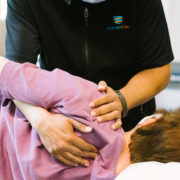
Everything You Need to Know About Swimmer’s Shoulder
The shoulder is one of the most important and complicated joints in the human body. As a ball-and-socket joint, it has an enormous range of motion. However, this range also means it is less stable than other types of joints.
Because of this, the shoulder is susceptible to overuse injuries from overhead sports such as swimming. In fact, shoulder injuries account for 90% of complaints swimmers bring to their doctors. But what is swimmer’s shoulder, and what can you do about it?
What Causes Swimmer’s Shoulder?
Swimmer’s shoulder (sometimes called swimmer’s syndrome) is more accurately known as shoulder impingement. It is most common in swimmers but also seen in individuals who engage in activities with a lot of over-the-head rotational motion. This includes sports such as swimming, baseball, volleyball, and tennis. However, shoulder impingement can also be caused by manual labor like painting or washing windows.

On a physiological level, swimmer’s shoulder starts like many other muscle injuries. It occurs due to overuse when excessive repeated circular motions of the arm cause injury and swelling. This in turn causes inflammation in the rotator cuff.
When the tendons in the shoulder joint become inflamed, they can be further irritated by the top outer edge of the shoulder blade, called the acromion. The swelling spurs a vicious cycle of irritation and swelling that causes more rubbing (or impingement) of the tendons in the joint and causes pain, weakness, and mobility issues.
What are the Symptoms of Swimmer’s Shoulder?
The main symptoms of swimmer’s shoulder are:
- Pain in the shoulder
- Instability or joint laxity in the shoulder
- Reduced strength
- Reduced mobility
If you are displaying these symptoms, you may have swimmer’s shoulder. Do not continue exercising that shoulder and contact a sports medicine expert or an orthopedic doctor. They will be able to assess your situation, order scans, and determine the extent of your injury.
How is Swimmer’s Shoulder Treated?
In most cases, conservative (non-surgical) treatments relieve pain, reduce swelling, and allow the damaged tissue to heal. Applying heat or ice, resting the shoulder, and taking over-the-counter pain medication are often recommended. Your orthopedic doctor may also recommend additional non-surgical treatment, including the following.
Lifestyle Adjustments
The most basic steps to take are those that reduce the need for repetitive movement in daily life. For manual laborers, this can take the form of incorporating breaks, stretches, or different approaches to work into their daily routine. For athletes, this can mean modifying workouts and consulting with a sports medicine specialist to utilize proper technique and continue training.
Physical Therapy
A physical therapist can guide shoulder impingement stretches and shoulder impingement exercises to restore mobility and strength to the shoulder. This helps the shoulder heal after the injury and is also used after shoulder surgery if conservative treatments do not work.
Steroid Injection
Of the conservative treatments, the most direct is a shot of steroid medication to the affected area to reduce inflammation. This is not a permanent fix but can provide temporary relief from more intense pain as the patient rests and heals.
When Do You Need Shoulder Impingement Surgery?
While most people do not need surgery for swimmer’s shoulder, if conservative treatments do not alleviate pain and restore function, shoulder impingement surgery may be necessary. This is typically recommended if symptoms persist six months to a year after the initial injury.
The minimally invasive approach for this is arthroscopic shoulder surgery, where a surgeon works through a small incision in the shoulder using a camera. This is a popular option, and 90% of arthroscopic rotator cuff repair patients report improvement. For the most severe cases, a more invasive procedure is subacromial decompression, where a surgeon removes bone spurs and inflamed tissue in the shoulder.
Emerge Stronger, Healthier, and Better
If you have been experiencing shoulder pain, do not wait to seek help. The best results come from addressing issues quickly, and consulting with an orthopedic sports medicine specialist at EmergeOrtho—Triangle Region. We encourage you to schedule an appointment or call us any time at (919) 220-5255.








